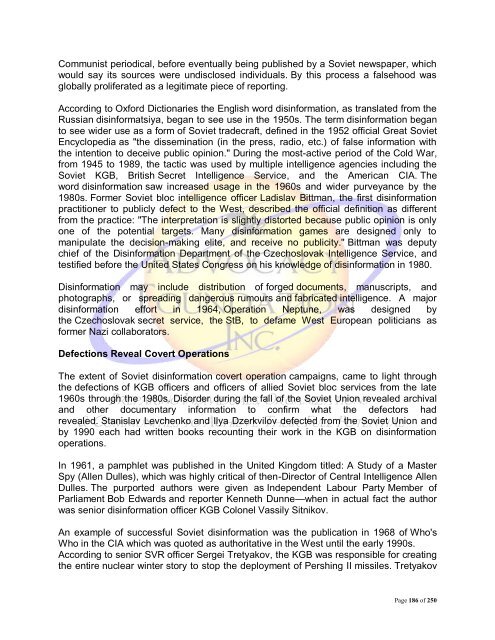Institutional Racism
Institutional Racism
Institutional Racism
Create successful ePaper yourself
Turn your PDF publications into a flip-book with our unique Google optimized e-Paper software.
Communist periodical, before eventually being published by a Soviet newspaper, which<br />
would say its sources were undisclosed individuals. By this process a falsehood was<br />
globally proliferated as a legitimate piece of reporting.<br />
According to Oxford Dictionaries the English word disinformation, as translated from the<br />
Russian disinformatsiya, began to see use in the 1950s. The term disinformation began<br />
to see wider use as a form of Soviet tradecraft, defined in the 1952 official Great Soviet<br />
Encyclopedia as "the dissemination (in the press, radio, etc.) of false information with<br />
the intention to deceive public opinion." During the most-active period of the Cold War,<br />
from 1945 to 1989, the tactic was used by multiple intelligence agencies including the<br />
Soviet KGB, British Secret Intelligence Service, and the American CIA. The<br />
word disinformation saw increased usage in the 1960s and wider purveyance by the<br />
1980s. Former Soviet bloc intelligence officer Ladislav Bittman, the first disinformation<br />
practitioner to publicly defect to the West, described the official definition as different<br />
from the practice: "The interpretation is slightly distorted because public opinion is only<br />
one of the potential targets. Many disinformation games are designed only to<br />
manipulate the decision-making elite, and receive no publicity." Bittman was deputy<br />
chief of the Disinformation Department of the Czechoslovak Intelligence Service, and<br />
testified before the United States Congress on his knowledge of disinformation in 1980.<br />
Disinformation may include distribution of forged documents, manuscripts, and<br />
photographs, or spreading dangerous rumours and fabricated intelligence. A major<br />
disinformation effort in 1964, Operation Neptune, was designed by<br />
the Czechoslovak secret service, the StB, to defame West European politicians as<br />
former Nazi collaborators.<br />
Defections Reveal Covert Operations<br />
The extent of Soviet disinformation covert operation campaigns, came to light through<br />
the defections of KGB officers and officers of allied Soviet bloc services from the late<br />
1960s through the 1980s. Disorder during the fall of the Soviet Union revealed archival<br />
and other documentary information to confirm what the defectors had<br />
revealed. Stanislav Levchenko and Ilya Dzerkvilov defected from the Soviet Union and<br />
by 1990 each had written books recounting their work in the KGB on disinformation<br />
operations.<br />
In 1961, a pamphlet was published in the United Kingdom titled: A Study of a Master<br />
Spy (Allen Dulles), which was highly critical of then-Director of Central Intelligence Allen<br />
Dulles. The purported authors were given as Independent Labour Party Member of<br />
Parliament Bob Edwards and reporter Kenneth Dunne—when in actual fact the author<br />
was senior disinformation officer KGB Colonel Vassily Sitnikov.<br />
An example of successful Soviet disinformation was the publication in 1968 of Who's<br />
Who in the CIA which was quoted as authoritative in the West until the early 1990s.<br />
According to senior SVR officer Sergei Tretyakov, the KGB was responsible for creating<br />
the entire nuclear winter story to stop the deployment of Pershing II missiles. Tretyakov<br />
Page 186 of 250

















